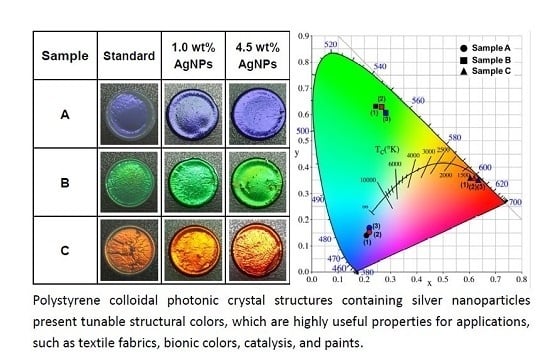Colloidal Photonic Crystals Containing Silver Nanoparticles with Tunable Structural Colors
Abstract
:1. Introduction
2. Results
2.1. Optical Properties of High-Concentration AgNPs
2.2. Crystal Structures of the Prepared AgNPs/PS Hybrid CPhC Color Films
2.3. Effects of AgNPs Content on PS CPhC Color Films
3. Discussion
4. Materials and Methods
4.1. Materials
4.2. Synthesis of PS-Based Nanospheres
4.3. Attachment of AgNPs to Colloidal PS Latex
4.4. Characterization
5. Conclusions
Supplementary Materials
Acknowledgments
Author Contributions
Conflicts of Interest
Abbreviations
| PS | polystyrene |
| CPhCs | colloidal photonic crystals |
| NPs | nanoparticles |
| PSB | photonic stop band |
| CB | carbon black |
| Au | gold |
| Ag | silver |
| LSPR | localized surface plasmon resonance |
| fcc | face-centered cubic |
| FESEM | field-emission scanning electron microscopy |
| FETEM | field-emission transmission electron microscope |
| DLS | dynamic light scattering |
| LPSA | laser particle size analyzer |
| EDS | energy dispersive spectrometer |
| CIE | Commission International d’Eclairage |
| wt % | weight percent |
References
- Cong, H.; Yu, B.; Tang, J.; Li, Z.; Liu, X. Current status and future developments in preparation and application of colloidal crystals. Chem. Soc. Rev. 2013, 42, 7774–7800. [Google Scholar] [CrossRef] [PubMed]
- Stein, A.; Wilson, B.E.; Rudisill, S.G. Design and functionality of colloidal-crystal-templated materials-chemical applications of inverse opals. Chem. Soc. Rev. 2013, 42, 2763–2803. [Google Scholar] [CrossRef] [PubMed]
- Vogel, N.; Retsch, M.; Fustin, C.A.; Campo, A.D.; Jonas, U. Advances in Colloidal Assembly: The Design of Structure and Hierarchy in Two and Three Dimensions. Chem. Rev. 2015, 115, 6265–6311. [Google Scholar] [CrossRef] [PubMed]
- Aguirre, C.I.; Reguera, E.; Stein, A. Tunable Colors in Opals and Inverse Opal Photonic Crystals. Adv. Funct. Mater. 2010, 20, 2565–2578. [Google Scholar] [CrossRef]
- Li, Y.; Duan, G.; Liu, G.; Cai, W. Physical processes-aided periodic micro/nanostructured arrays by colloidal template technique: Fabrication and applications. Chem. Soc. Rev. 2013, 42, 3614–3627. [Google Scholar] [CrossRef] [PubMed]
- Lai, C.F.; Lee, Y.C.; Tsai, T.L. Candlelight LEDs fabricated by using composite silica photonic crystals. Opt. Mater. Express 2015, 5, 307–313. [Google Scholar] [CrossRef]
- Lai, C.F.; Lee, Y.C.; Kuo, C.T. Saving phosphor by 150% and producing high color-rendering index candlelight LEDs containing composite photonic crystals. J. Light. Technol. 2014, 32, 1930–1935. [Google Scholar] [CrossRef]
- Klein, S.M.; Manoharan, V.N.; Pine, D.J.; Lange, F.F. Preparation of monodisperse PMMA microspheres in nonpolar solvents by dispersion polymerization with a macromonomeric stabilizer. Colloid Polym. Sci. 2003, 282, 7–13. [Google Scholar] [CrossRef]
- Zhang, Y.; Dong, B.; Chen, A.; Liu, X.; Shi, L.; Zi, J. Using Cuttlefish Ink as an Additive to Produce Non-iridescent Structural Colors of High Color Visibility. Adv. Mater. 2015, 27, 4719–4724. [Google Scholar] [CrossRef] [PubMed]
- Tang, B.; Xu, Y.; Lin, T.; Zhang, S. Polymer opal with brilliant structural color under natural light and white environment. J. Mater. Res. 2015, 30, 3134–3141. [Google Scholar] [CrossRef]
- Wang, F.; Gou, Z.; Ge, Y.; An, K. Preparation of tunable structural colour film by coating ps with titania on glass. Micro. Nano Lett. 2016, 11, 50–53. [Google Scholar] [CrossRef]
- Wang, F.; Zhang, X.; Zhang, L.; Cao, M.; Lin, Y.; Zhu, J. Rapid fabrication of angle-independent structurally colored films with a superhydrophobic property. Dyes Pigment 2016, 130, 202–208. [Google Scholar] [CrossRef]
- Cong, H.; Yu, B.; Wang, S.; Qi, L.; Wang, J.; Ma, Y. Preparation of iridescent colloidal crystal coatings with variable structural colors. Opt. Express 2013, 21, 17831–17838. [Google Scholar] [CrossRef] [PubMed]
- Aguirre, C.I.; Reguera, E.; Stein, A. Colloidal Photonic Crystal Pigments with Low Angle Dependence. ACS Appl. Mater. Interfaces 2010, 2, 3257–3262. [Google Scholar] [CrossRef] [PubMed]
- Shen, Z.; Shi, L.; You, B.; Wu, L.; Zhao, D. Large-scale fabrication of three-dimensional ordered polymer films with strong structure colors and robust mechanical properties. J. Mater. Chem. 2012, 22, 8069–8075. [Google Scholar] [CrossRef]
- Wang, W.; Tang, B.; Ma, W.; Zhang, J.; Ju, B.; Zhang, S. Easy approach to assembling a biomimetic color film with tunable structural colors. J. Opt. Soc. Am. A 2015, 32, 1109–1117. [Google Scholar] [CrossRef] [PubMed]
- Pursiainen, O.L.; Baumberg, J.J.; Winkler, H.; Viel, B.; Spahn, P.; Ruhl, T. Nanoparticle-tuned structural color from polymer opals. Opt. Express 2007, 15, 9553–9561. [Google Scholar] [CrossRef] [PubMed]
- Yamada, Y.; Ishii, M.; Nakamura, T.; Yano, K. Artificial Black Opal Fabricated from Nanoporous Carbon Spheres. Langmuir 2010, 26, 10044–10049. [Google Scholar] [CrossRef] [PubMed]
- Wang, F.; Zhang, X.; Lin, Y.; Wang, L.; Zhu, J. Structural Coloration Pigments based on Carbon Modified ZnS@SiO2 Nanospheres with Low-Angle Dependence, High Color Saturation, and Enhanced Stability. ACS Appl. Mater. Interfaces 2016, 8, 5009–5016. [Google Scholar] [CrossRef] [PubMed]
- Wang, F.; Zhang, X.; Lin, Y.; Wang, L.; Qin, Y.; Zhu, J. Fabrication and characterization of structurally colored pigments based on carbon-modified ZnS nanospheres. J. Mater. Chem. C 2016, 4, 3321–3327. [Google Scholar] [CrossRef]
- Erola, M.O.A.; Philip, A.; Ahmed, T.; Suvanto, S.; Pakkanen, T.T. Fabrication of Au- and Ag-SiO2 inverse opals having both localized surface plasmon resonance and Bragg diffraction. J. Sol. Stat. Chem. 2015, 230, 209–217. [Google Scholar] [CrossRef]
- Yu, B.; Zhai, F.; Cong, H.; Yang, D. Photosensitive polystyrene/silver bromide hybrid colloidal crystals as recoverable colorimetric naked eye probes for bromine gas sensing. J. Mater. Chem. C 2016, 4, 1386–1391. [Google Scholar] [CrossRef]
- Lai, C.F.; Wang, Y.C.; Wu, C.L.; Zeng, J.Y.; Lin, C.F. Preparation of a colloidal photonic crystal containing CuO nanoparticles with tunable structural colors. RSC Adv. 2015, 5, 105200–105205. [Google Scholar] [CrossRef]
- Mu, Z.; Zhao, X.; Huang, Y.; Lu, M.; Gu, Z. Photonic Crystal Hydrogel Enhanced Plasmonic Staining for Multiplexed Protein Analysis. Small 2015, 11, 6036–6043. [Google Scholar] [CrossRef] [PubMed]
- Zhao, X.; Xue, J.; Mu, Z.; Huang, Y.; Lu, M.; Gu, Z. Gold nanoparticle incorporated inverse opal photonic crystal capillaries for optofluidic surface enhanced Raman spectroscopy. Biosens. Bioelectron. 2015, 72, 268–274. [Google Scholar] [CrossRef] [PubMed]
- Ji, X.; Song, X.; Li, J.; Bai, Y.; Yang, W.; Peng, X. Size Control of Gold Nanocrystals in Citrate Reduction: The Third Role of Citrate. J. Am. Chem. Soc. 2007, 129, 13939–13948. [Google Scholar] [CrossRef] [PubMed]
- Yadav, A.; Danesh, M.; Zhong, L.; Cheng, G.J.; Jiang, L.; Chi, L. Spectral plasmonic effect in the nano-cavity of dye-doped nanosphere-jbased photonic crystals. Nanotechnology 2016, 27, 165703. [Google Scholar] [CrossRef] [PubMed]
- Wang, D.; Zhou, F.; Wang, C.; Liu, W. Synthesis and characterization of silver nanoparticle loaded mesoporous TiO2 nanobelts. Microporous Mesop. Mater. 2008, 116, 658–664. [Google Scholar] [CrossRef]
- Sondi, I.; Salopekk-Sondi, B. Silver nanoparticles as antimicrobial agent: A case study on E. coli as a model for Gram-negative bacteria. J. Colloid Interfaces Sci. 2004, 275, 177–182. [Google Scholar] [CrossRef] [PubMed]
- Ashokkumar, S.; Ravi, S.; Kathiravan, V.; Velmurugan, S. Synthesis, characterization and catalytic activity of silver nanoparticles using Tribulus terrestric leaf extract. Spectrochim. Act. Part A Mol. Biomol. Spectrosc. 2014, 121, 88–93. [Google Scholar] [CrossRef] [PubMed]
- Haider, A.; Kang, I.K. Preparation of Silver Nanoparticles and Their Industrial and Biomedical Applications: A Comprehensive Review. Adv. Mater. Sci. Eng. 2015, 2015, 165257. [Google Scholar] [CrossRef]
- Gabriel Ortega-Mendoza, J.; Padilla-Vivanco, A.; Tozqui-Quitl, C.; Zaca-Moran, P.; Villegas-Hernandez, D.; Chavez, F. Optical Fiber Sensor Based on Localized Surface Plasmon Resonance Using Silver Nanoparticles Photodeposited on the Optical Fiber End. Sensors 2014, 14, 18701–18710. [Google Scholar] [CrossRef] [PubMed]
- Henglein, A. Colloidal Silverr Nanoparticles: Photochemical Preparation and Interaction with O2, CCl4, and Some Metal Ions. Chem. Mater. 1998, 10, 444–450. [Google Scholar] [CrossRef]
- Pal, S.; Tak, Y.K.; Song, J.M. Does the Antibacterial Activity of Silver Nanoparticles Depend on the Shape of the Nanoparticle? A Study of the Gram-Negative Bacterium Escherichia Coli. Appl. Environ. Microbiol. 2007, 73, 1712–1720. [Google Scholar] [CrossRef] [PubMed]
- Deegan, R.D.; Bakajin, O.; Dupont, T.F.; Huber, G.; Nagel, S.R.; Witten, T.A. Capillary flow as the cause of ring stains from dried liquid drops. Nature 1997, 389, 827–829. [Google Scholar] [CrossRef]
- Deegan, R.D.; Bakajin, O.; Dupont, T.F.; Huber, G.; Nagel, S.R.; Witten, T.A. Contact line deposits in an evaporating drop. Phys. Rev. E 2000, 62, 756. [Google Scholar] [CrossRef]
- Deegan, R.D. Pattern formation in drying drops. Phys. Rev. E 2000, 61, 475. [Google Scholar] [CrossRef]
- Li, F.; Tang, B.; Xiu, J.; Zhang, S. Hydrophilic Modification of Multi-Walled Carbon Nanotube for Building Photonic Crystals with Enhanced Color Visibility and Mechanical Strength. Molecules 2016, 21, 547. [Google Scholar] [CrossRef] [PubMed]

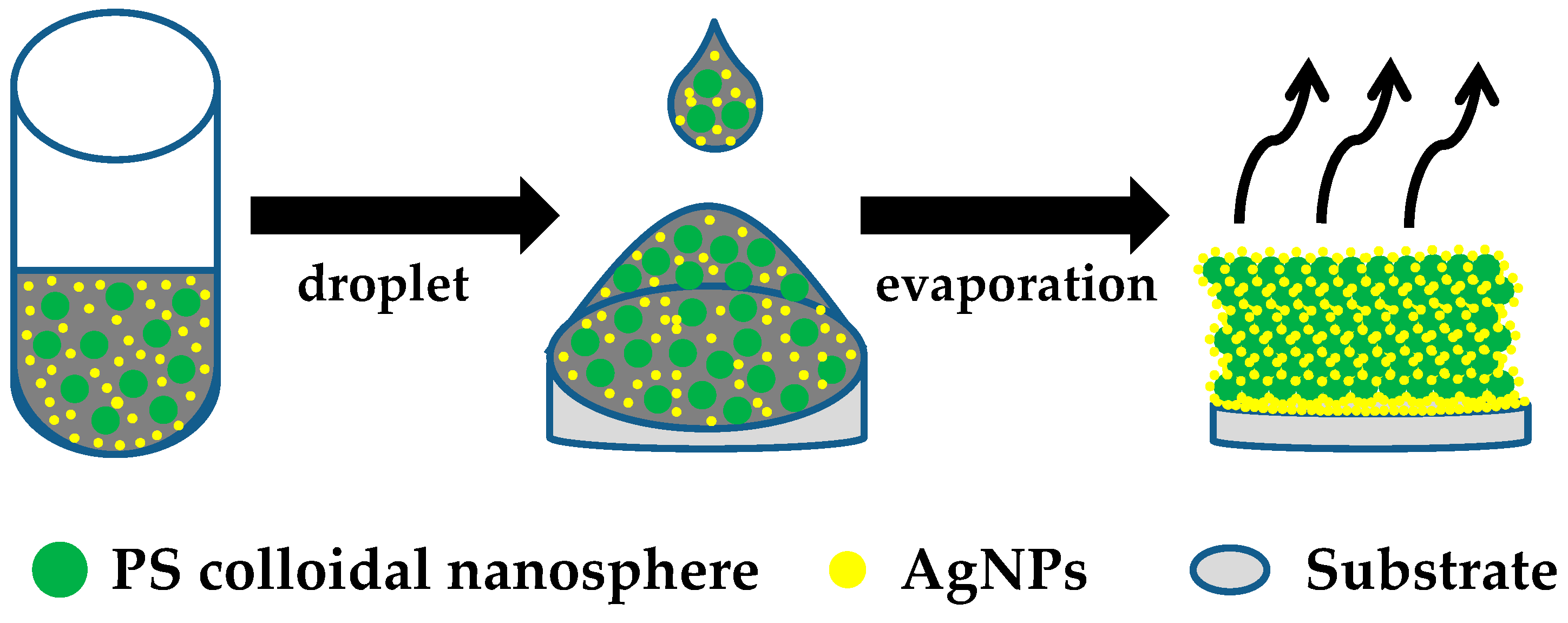
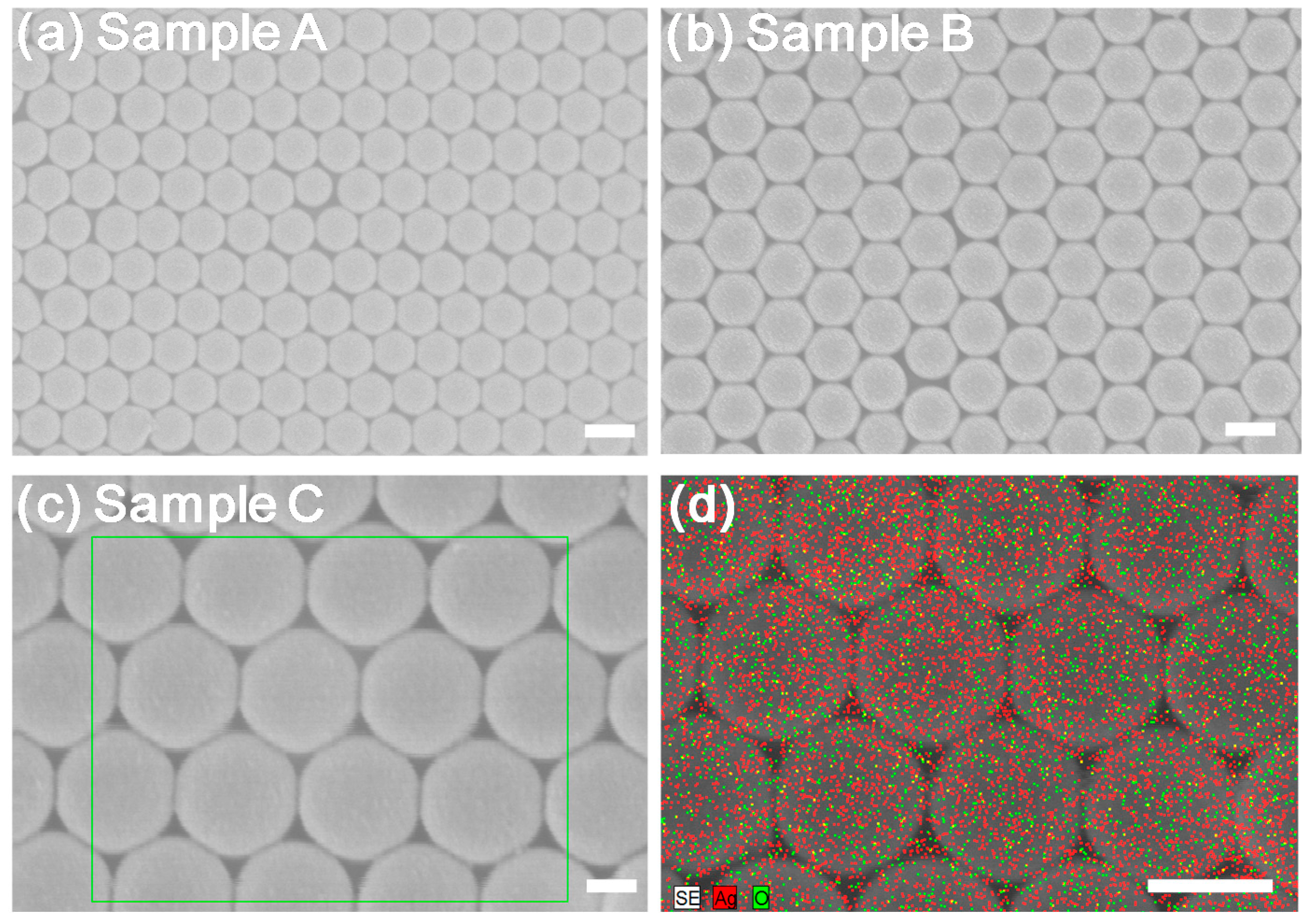
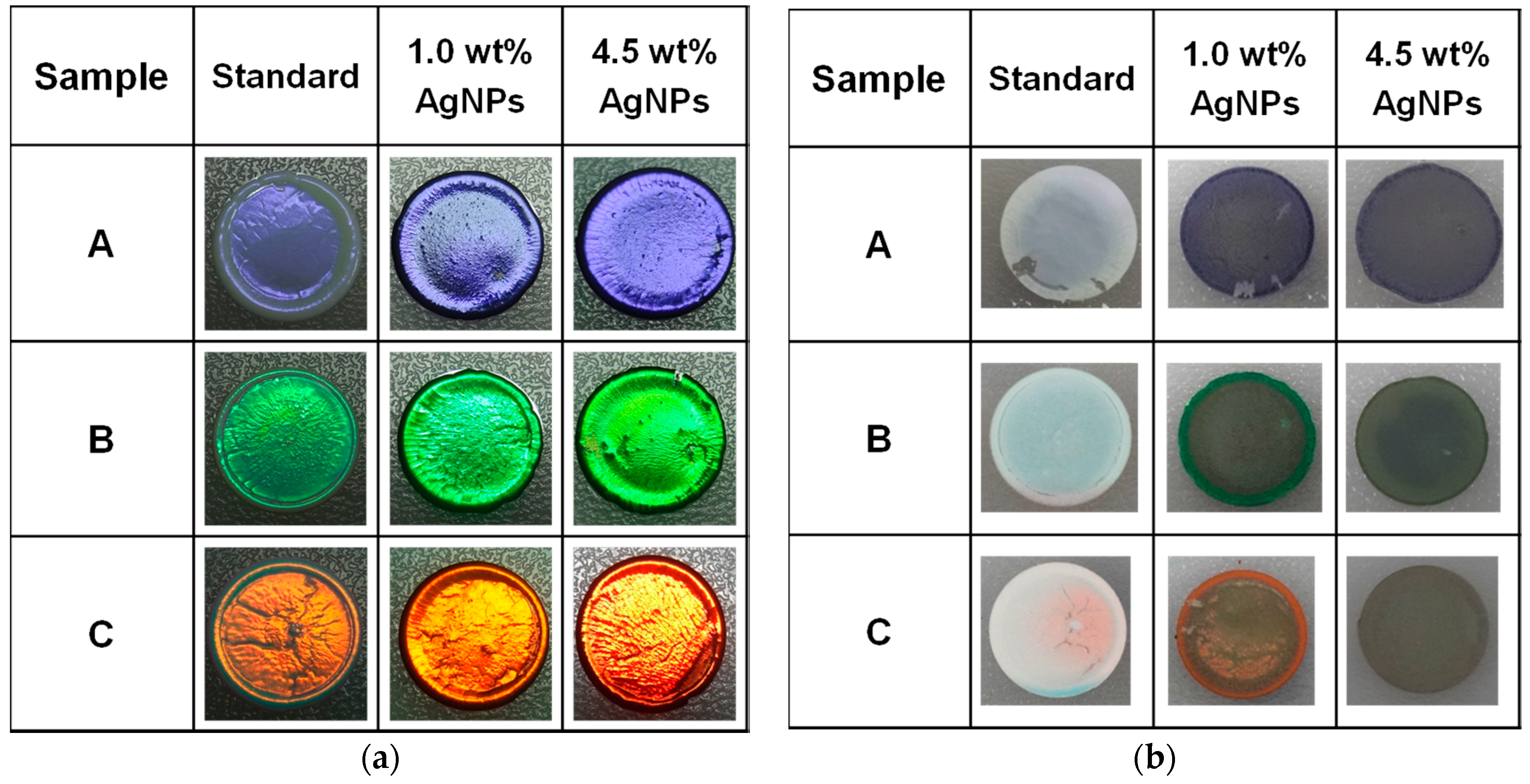
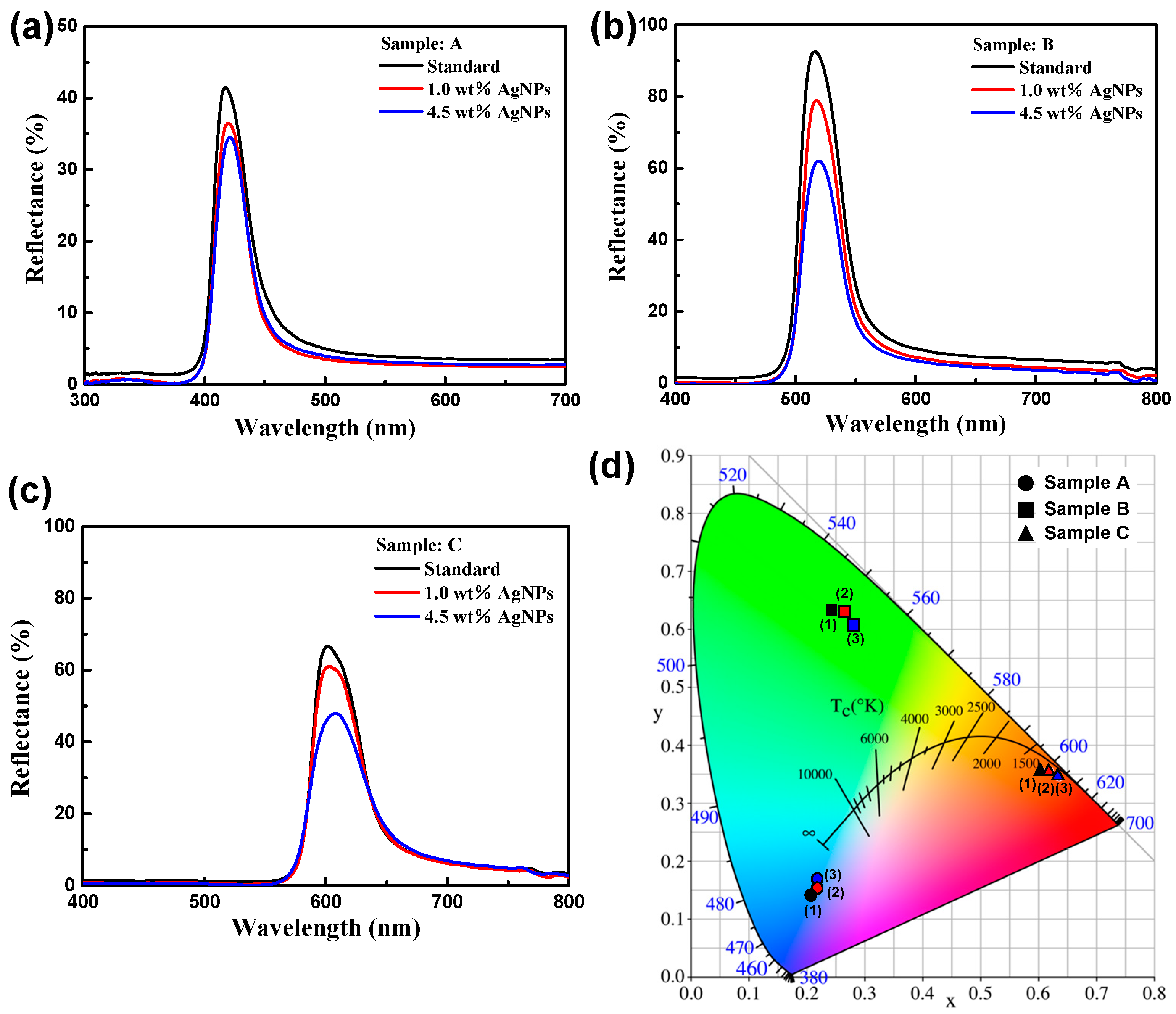
| Sample | Diameter (DPS, nm) | PDI | AgNP Concentrations (wt %) | |
|---|---|---|---|---|
| FESEM | LPSA | |||
| A | 170 | 189.5 | 0.040 | 1.0/4.5 |
| B | 215 | 233.3 | 0.028 | |
| C | 250 | 267.1 | 0.043 | |
© 2016 by the authors; licensee MDPI, Basel, Switzerland. This article is an open access article distributed under the terms and conditions of the Creative Commons Attribution (CC-BY) license (http://creativecommons.org/licenses/by/4.0/).
Share and Cite
Lai, C.-F.; Wang, Y.-C. Colloidal Photonic Crystals Containing Silver Nanoparticles with Tunable Structural Colors. Crystals 2016, 6, 61. https://doi.org/10.3390/cryst6050061
Lai C-F, Wang Y-C. Colloidal Photonic Crystals Containing Silver Nanoparticles with Tunable Structural Colors. Crystals. 2016; 6(5):61. https://doi.org/10.3390/cryst6050061
Chicago/Turabian StyleLai, Chun-Feng, and Yu-Chi Wang. 2016. "Colloidal Photonic Crystals Containing Silver Nanoparticles with Tunable Structural Colors" Crystals 6, no. 5: 61. https://doi.org/10.3390/cryst6050061




